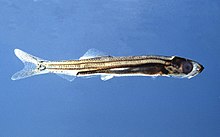FishBase
FishBase is an online - database with information and pictures of more than 34,100 species of fish , 324,100 names, 59,400 images, 55,700 references and 2,330 partners. The site with an average of 100,000 hits per month is offered free of charge. It can also be purchased on CD-ROM . The partners provide images and videos free of charge, but retain the copyright . Much data can be plotted against each other from any browser . Entries for which the geographical coordinates are known can be displayed as interactive maps. An identification key and several teaching projects are also included.
Creation of the FishBase
The first versions of a computerized fish database and identification aid with images ( imageSYS ) were developed in 1985 in the fishery biology department of the Institute for Oceanography in Kiel, where the directors Gotthilf Hempel and Walter Nellen generously acquired computers and programs.
Fishbase online

The first version with interactive hyperlinks and colored photos was programmed by Uwe Kils on the first NeXT workstation of the University of Kiel in the “ Communication ” project of the Volkswagen Foundation and tested in internships with teaching students, then in 1994 one donated by the D'art Corporation NeXT-colorstation booted as the institute's first WWW server. The first fish database was programmed like today's wiki , anyone could add or edit over the Internet without a password.
The fish larvae identification key from Hans Wilhelm Halbeisen was incorporated by Wolfgang Schöfer . One of the students, Rainer Froese , pushed the vision further and founded the first financed version in Manila together with Daniel Pauly . Anyone can send in images and data, but biologists decide on the recording and identification. Today FishBase has a lot of permanent, paid employees and the head office has since moved back to Kiel. The LarvalBase project started by Bernd Ueberschaer in 1998 was integrated. FishBase was part of the global OBIS (Ocean Biogeographic Information System) project (Ocean Biogeographic Information System with 5,253,721 sites, 50,932 scientific names, 38,012 species, from 25 sources), started in 1998 by Frederick Grassle and Karen Stocks at Rutgers University , Institute of Marine and Coastal Sciences ) by clicking on a map of the world and thus gaining access to all (previously integrated) marine organisms living there.
Visions
OBIS visions are that live insights into the ocean via webcams and underwater microscopes ( ecoSCOPE ) can be integrated in order to be able to interactively identify the species occurring in the area. The first tests are running in the LEO15 project in front of Atlantic City and with expert servers at species level , e.g. B. Black grouper with reference images and videos recorded in situ . For some key species, the possibility is to be created of interactively looking into the microstructures of the morphology with a so-called virtual microscope ( virtual dissection down to electron microscopic resolution) without having to kill an animal, as is already available in a test version on the Antarctic krill .
Web links
Texts mostly in English
- FishBase search page
- FishBase - A Global Information System on Fishes
- Rutgers University: Institute of Marine and Coastal Sciences
- OBIS - Ocean Biogeographic Information System
- SeaLifeBase search page
- LarvalBase - Global Information System about FishLarvae
Individual evidence
- ↑ FishBase - Home. FishBase, accessed January 13, 2019 .
- ^ FishBase Usage on the Web. FishBase, accessed January 13, 2019 .

